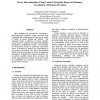Free Online Productivity Tools
i2Speak
i2Symbol
i2OCR
iTex2Img
iWeb2Print
iWeb2Shot
i2Type
iPdf2Split
iPdf2Merge
i2Bopomofo
i2Arabic
i2Style
i2Image
i2PDF
iLatex2Rtf
Sci2ools
ISVD
2007
IEEE
2007
IEEE
Decoy Discrimination Using Contact Potentials Based on Delaunay Tessellation of Hydrated Proteins
Three strategies are presented for developing a knowledge-based statistical contact potential from computationally hydrated proteins that may be useful in studies of protein folding and stability. The potentials employ a definition of nearest neighbor contact based on Delaunay tessellation that identifies quadruplets of neighboring residues. The potentials are derived from a large set of proteins with explicit waters of hydration to improve the representation of the protein environment. The decoy discrimination ability of the three potentials as well as an unhydrated potential are evaluated and compared using four sets of publicly available protein decoy structures. The results suggest that the potentials can be used to infer the compatibility of a sequence of residues with a specific protein structure.
| Added | 04 Jun 2010 |
| Updated | 04 Jun 2010 |
| Type | Conference |
| Year | 2007 |
| Where | ISVD |
| Authors | Gregory M. Reck, Iosif I. Vaisman |
Comments (0)

